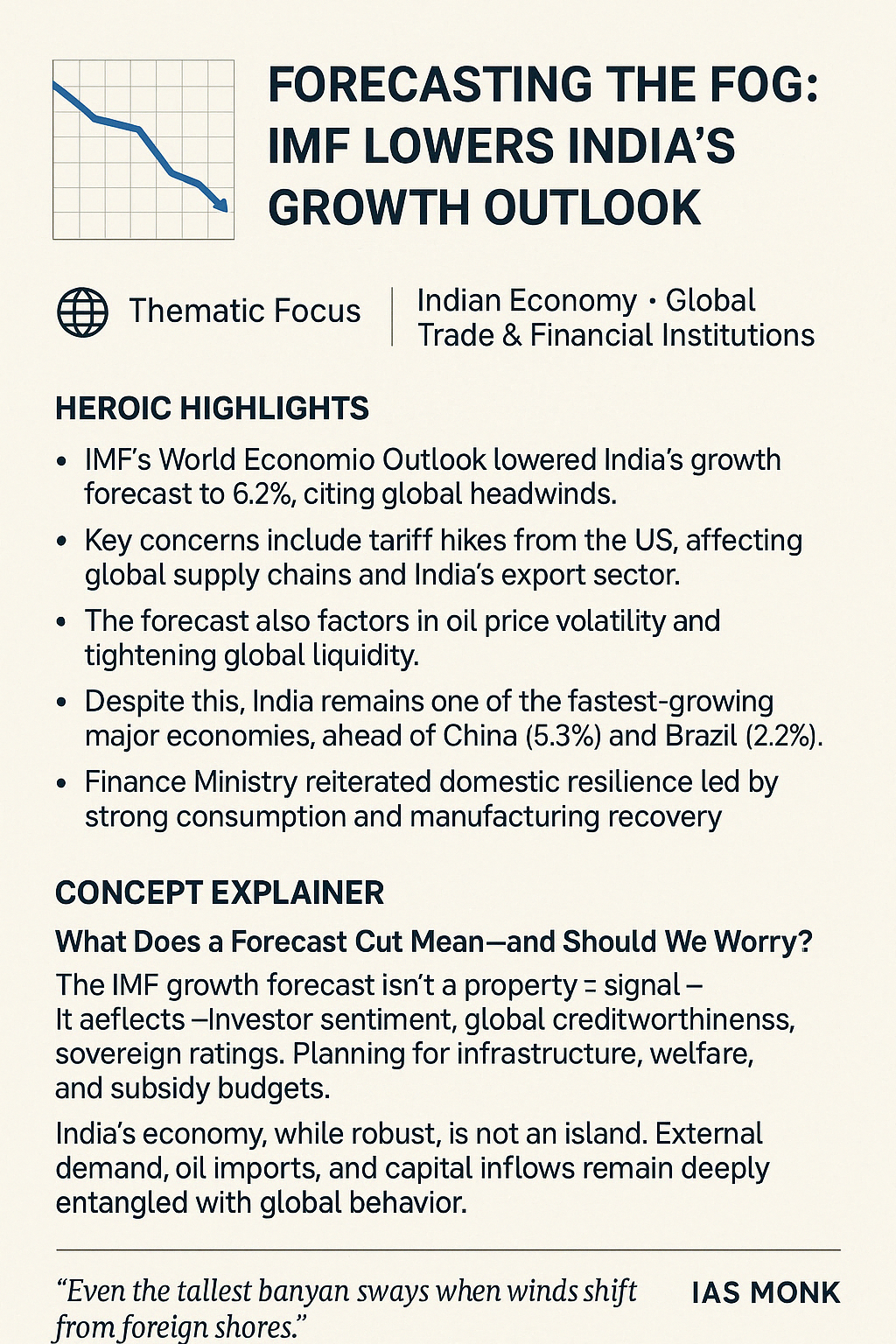
003-Apr 22, 2025 : 📉Forecasting the Fog: IMF Lowers India’s Growth Outlook

📅 April 22, 2025
📌 Highlight: Relevant Essay Attached
Thematic Focus
💼 Indian Economy | 🌐 Global Trade & Financial Institutions
Intro
Amid shifting tides of global trade, the International Monetary Fund (IMF) released a fresh breeze of caution on April 22, 2025. India’s projected growth for FY2025–26 has been revised downward—from 6.5% to 6.2%. The reasons? A swirling mix of geopolitical uncertainties, volatile oil prices, and escalating global tariff tensions, particularly from the United States.
Though modest on paper, this dip serves as a mirror—revealing the vulnerability of emerging economies to foreign policy winds beyond their own control.
Heroic Highlights
- IMF’s World Economic Outlook lowered India’s growth forecast to 6.2%, citing global headwinds.
- Key concerns include tariff hikes from the US, affecting global supply chains and India’s export sector.
- The forecast also factors in oil price volatility and tightening global liquidity.
- Despite this, India remains one of the fastest-growing major economies, ahead of China (5.3%) and Brazil (2.2%).
- Finance Ministry issued a statement reaffirming domestic resilience led by strong consumption and manufacturing recovery.
- The rupee saw mild depreciation post-announcement, while equity markets showed measured response.
Concept Explainer
What Does a Forecast Cut Mean—and Should We Worry?
The IMF growth forecast isn’t a prophecy—it’s a signal. It reflects global perception and policy pulse. A 0.3% drop may seem minor, but it impacts:
- Investor sentiment in FDI and capital markets.
- Global creditworthiness and sovereign ratings.
- Planning for infrastructure, welfare, and subsidy budgets.
India’s economy, while robust, is not an island. External demand, oil imports, and capital inflows remain deeply entangled with global behavior.
GS Paper Mapping
- GS Paper 3: Indian Economy – Growth, inflation, monetary policy, and global trade
- GS Paper 2: International Institutions – IMF’s role, WTO dynamics, global governance
- Essay Paper: Resilience of emerging economies in a turbulent world order
A Thought Spark — by IAS Monk
“Even the tallest banyan sways when winds shift from foreign shores.”
Our strength lies not in resisting storms—but in anchoring policies deep enough to survive them. Let this be a reminder: economies grow not just through numbers, but through trust.
Essay
Navigating Global Headwinds – India’s Growth Outlook and IMF Signals
“Even the tallest banyan sways when winds shift from foreign shores.”
Introduction
On April 22, 2025, the International Monetary Fund (IMF) revised India’s growth forecast for the fiscal year 2025–26, bringing it down from 6.5% to 6.2%. Though seemingly modest, this revision signals a broader caution within the global financial landscape. As India continues to stand out as one of the world’s fastest-growing major economies, the cut is a reminder that its trajectory, while hopeful, is still vulnerable to global tremors.
Understanding the Forecast Cut
The IMF’s growth projection is not a prediction—it is a signal. A downward revision implies that the underlying assumptions about the global economy have changed. In this case, concerns over global trade tensions, especially rising US tariffs, and commodity market volatility have played a role. For India, an export-driven manufacturing push, coupled with reliance on imported crude, means such shifts can have downstream economic implications.
The Role of Global Trade and Policy Tensions
One of the IMF’s key concerns is the ongoing uncertainty in global trade policy. With the United States increasing tariff barriers under new economic safeguards, India’s export competitiveness could take a hit. These policies disrupt global supply chains, affecting not just bilateral trade, but broader investor sentiment.
Additionally, oil prices remain volatile. Any prolonged instability in West Asia, or supply constraints triggered by geopolitical tensions, could strain India’s current account deficit and increase inflationary pressures.
India’s Domestic Strengths – A Buffer Against the Storm
Despite global headwinds, India retains a strong foundation. The Finance Ministry responded to the IMF revision by reiterating its confidence in the economy’s internal resilience—pointing to robust consumption, a reviving real estate sector, and expanding formal employment.
Sectors like digital infrastructure, renewable energy, and micro, small, and medium enterprises (MSMEs) continue to attract attention. In fact, India’s projected growth rate still places it ahead of several peers, including China (5.3%) and Brazil (2.2%), reaffirming its relatively resilient outlook.
Why These Numbers Matter
A revision in GDP forecast affects more than just perception. It has practical consequences:
– It may influence sovereign credit ratings and investor inflows.
– It alters assumptions for government spending on infrastructure, welfare, and fiscal deficit targets.
– It changes how India is viewed in multilateral forums—from BRICS to G20 to World Bank panels.
Therefore, the real weight of such signals lies in their ripple effects—not in the decimal points.
Conclusion
India’s economic ship sails confidently, but not in isolation. Global tides—whether of policy, oil, or conflict—inevitably rock the deck. The latest IMF forecast may be a small adjustment numerically, but it is a large one strategically. It calls for caution, flexibility, and foresight.
As India dreams of becoming a $5 trillion economy, the lesson is clear: growth isn’t just about accelerating—it’s about anchoring wisely amidst turbulence.
What we need is not fear—but fluent adaptation. And in that lies true economic wisdom.
“The real compass of an economy is not speed—but balance.”
📘 Download this Essay as a PDF
(Currently free — soon a nominal ₹5 download fee will apply)


















